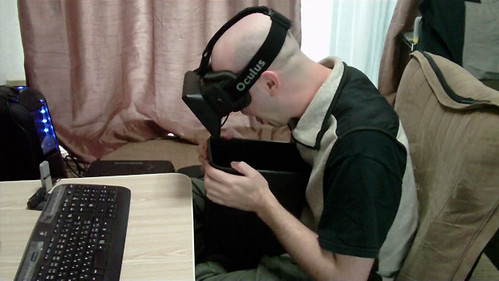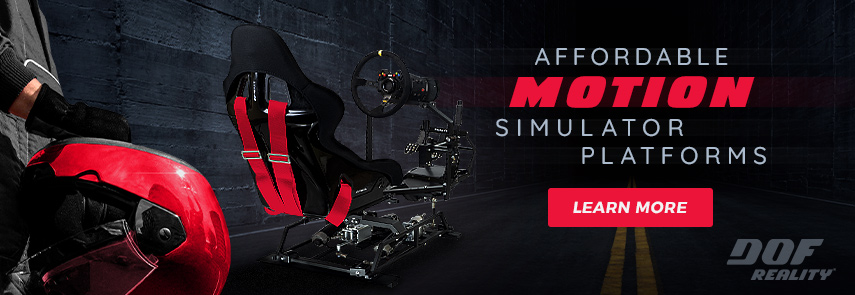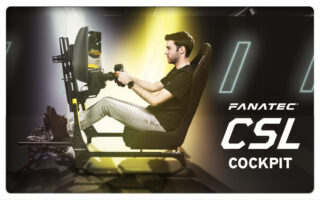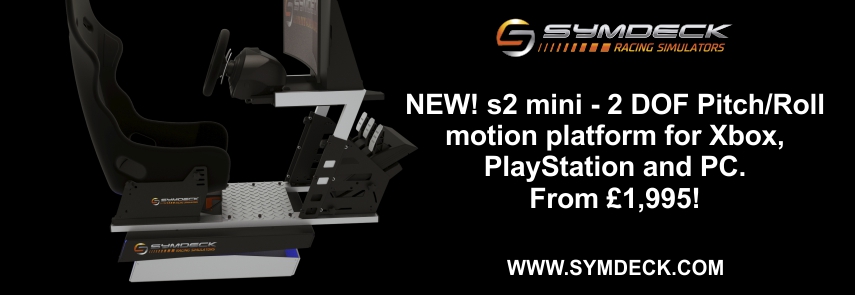While browsing the web for sim racing news, I came across an article on kotaku.com that really attracted my interest.
Since I am blind on the left side since birth, Virtual reality glasses or goggles like the Oculus Rift have always been a mystery to me. The technology relies on stereoscopic view, which I and so many others out there sadly enough don’t posses.
When the Oculus Rift was announced, and Sim Racing platforms began publishing articles about the tests they had done with the development kit, I felt a little disappointed, never be able to experience the next step in 3D gaming. Up until now, I always wondered what I would see using an advanced widescreen VR set like the Rift.
This is where the article by Richard Eisenbeis came to my attention. Richard is a gamer that has the use of two eyes, but had to get Lasik (Laser-Assisted) Surgery.
The surgery was a failure, and Richard now lost the use of one eye. Luckily they have foreseen a full recovery, but Richard will be effectively blind on one side for the coming months.
When he got his hands on an Oculus Rift Development kit, he decided to write the following article. For the most part its good news for all of us out there who have to miss the use of stereoscopic view.
Copy of the article:
A few weeks back, I received an email from a reader who was blind in one eye and wanted to know how the Oculus Rift would work for him. I thought it was an interesting question but honestly didn’t know the answer, so I put it to the back of my mind. Then this last weekend I went in for Lasik surgery. It didn’t go well.
Simply put, the surgery was a failure and while the doctor is hopeful that I will make a full recovery in the coming months, I have been effectively blind in my right eye for the past few days. So in an attempt to turn something horrible into something useful to others, I decided to see what Oculus Rift is like for those with only one functioning eye.
I started simple with a little tech demo called GirlMirrorLook. Basically, you are a girl in a small villa surrounded by beautiful scenery. There is also a mirror.
Now, in recent weeks, I had spent more than a little time with the Rift, but I was still surprised when I put the Rift on in my one-eyed state; everything still looked like it was in 3D. I still felt like I could reach out and touch the objects I was seeing,they just seemed a little flatter somehow. The objects didn’t quite pop out of the frame like they had before. After all, how could they? Stereoscopic 3D is impossible with just one eye.
However, due to the screen completely enveloping my peripheral vision, I was still visually immersed in the game. And since when I moved my head the camera moved identically in my Rift-vision, my brain seemed happy to interpret it as what I was really seeing,regardless of whether objects had the 3D “pop” or not.
I tried out another few tech demos,a room full of Hatsune Miku knock-offs, a Rift version ofTetris—and they seemed to be a comparably immersive experience to what I had had when playing the Rift with both eyes.
o it wasn’t until I tried playing Proton Pulse Rift, the first real game I ever played on the Rift, that the lack of Stereoscopic 3D became an issue. Proton Pulse is anArkanoid/Breakout-style game where you look down a long vector graphics corridor and block a bouncing ball with a semi-transparent paddle controlled by your head movements. Without the Stereoscopic 3D, it was much harder to judge how far the ball was from me at any given time. Like in the real world, I had lost my depth perception.
Lastly, I decided to try out something a bit more flashy and fast-paced in the form of Half Life 2: Episode 2. I only played through the first ten minutes or so, but there was one major issue I noticed when compared to my several hour stint last week with Half Life 2: Episode 1: the motion blur is much, much worse. Perhaps it is just that having two eyes lets you filter out the blur better, but every time I made a big, quick head or camera movement, my vision became little more than a mass of color. Despite this, however, the game was still quite playable.
In the end, I was really surprised at how well the Oculus Rift worked with only one eye. The immersion factor was still strong,I still felt like I was in the game and not in my living room. The motion blur and lack of depth perception were downsides to be sure, but everything was still perfectly playable.
And on one level, at least, playing one-eyed was definitely superior. I never felt even the least bit queasy.
Richard Eisenbeis –
| Read the original article at – http://kotaku.com/playing-occulus-rift-with-only-one-eye-1074765790 |
 Bsimracing Sim Racing Resources and News for the racing enthousiast.
Bsimracing Sim Racing Resources and News for the racing enthousiast.








